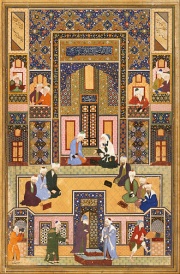Principles of Islamic banking and finance/PIBF201/Islamic jurisprudence/Schools
As mentioned earlier, the differences in interpreting verses of the Qur'an, the existence of alternative hadiths on a particular matter and the relative authenticity of these hadith and the individual efforts of religious scholars in deriving laws through the application of methods such as qiyas and ijtihad under their idiosyncratic methodology, has led to different schools of thought.
The Islamic banking and finance industry is heavily dependent on religious scholars for validation of its products and services. Each Islamic financial institution has a Shari'ah board to validate its operation. The scholars in a Shari'ah Board can be from different schools of thought. Furthermore, a scholar who may otherwise belong to a particular school of though does refer to the opinion of the past or present scholars of a different school of thought in making a decision on the validity of a product or service.
Contents
Schools of Thought (madhab) in Islam
The Amman Message of 2005, a three-point ruling issued by 200 Islamic scholars from over 50 countries, officially recognizes the following eight legal schools of thought.[1]
- Hanafi (Sunni)
- Maliki (Sunni)
- Shafi'i (Sunni)
- Hanbali (Sunni)
- Ja`fari (inc. Mustaali-Taiyabi Ismaili) (Shia)
- Zaidiyyah (Shia)
- Ibadiyyah.
- Zahiriyah.
The first four of the above belong to the majority Sunny sect of Islam whereas the last two are marginal sect with a very low following. Oman is the only country where followers of Ibadiyyah school are in majority whereas Iran and Iraq are Shia majority countries. In all other Muslim countries Sunnis are in majority and they follow one of the four schools of thought of Sunny Islam. The differences among them are not major as far as central beliefs in Islam are concerned. They generally belong to topics such as divorce, some details of prayers and also in business contract and transactions.
"All the four Imams of the Sunny madhabs had many common traits. They were very pious and religious. They were excellent in their religious knowledge. They had the rare intelligence and intuition in religious and common matters. Members of all the four held one another in high respect. The difference between them is on secondary points in religious jurisprudence which even the Prophet’s close companions had in their time. (Ashraf Ali [2]
The names of these schools were given after the founder of a particular methodology in Islamic jurisprudence. They are also called Imams (leaders). The real name of the founder of the Hanafi School was Nuʿmān ibn Thābit ibn Zūṭā ibn Marzubān. However, as common in Arabia he was popularly known as Abu Hanifah (meaning father of Hanifah). As his disciples largely followed his methodology of Islamic jurisprudence, gradually a school of thought was formed.
Hanafi Schhol
The sources from which the Hanafi madhhab (school) derives Islamic law are, in order of importance and preference: the Quran, and the hadiths containing the words, actions and customs of the Islamic prophet Muhammad (narrated in six hadith collections, of which Sahih Bukhari and Sahih Muslim are the most relied upon); if these sources were ambiguous on an issue, then the consensus of the Sahabah community (Ijma of the companions of Muhammad), then individual's opinion from the Sahabah, Qiyas (analogy), Istihsan (juristic preference), and finally local Urf (local custom of people. Abu Hanifa (7022-72 AD)is regarded by modern scholarship as the first to formally adopt and institute analogy (Qiyas) as a method to derive Islamic law when the Quran and hadiths are silent or could be differently interpreted in their guidance.[3]
Shafi School
The Shafi school (named after Abū ʿAbdillāh Muhammad ibn Idrīs al-Shāfi'ī, 757-820 AD)predominantly relies on the Quran and the Hadiths for Sharia. Where passages of Quran and Hadiths could be interpreted in different ways, the school first seeks religious law guidance from Ijma – the consensus of Sahabah (prophet's companions).If there was no consensus, the Shafi'i school relies on individual opinion (Ijtihad) of the companions of Muhammad, followed by analogy. [4]
Maliki School
The Mālikī school was founded by Malik ibn Anas in the 8th century. The Maliki school of jurisprudence relies on the Quran and hadiths as primary sources. Unlike other Islamic fiqhs, Maliki fiqh also considers the consensus of the people of Medina to be a valid source of Islamic law. Sharia based on Maliki doctrine is predominantly found in North Africa (excluding northern and eastern Egypt), West Africa, Chad, Sudan, Kuwait, Bahrain,the Emirate of Dubai (UAE), and in northeastern parts of Saudi Arabia. [5]
Hanbali School
The hambali School is named after the Iraqi scholar Ahmad ibn Hanbal (d. 855), and was institutionalized by his students. Hanbali school derives Sharia predominantly from the Quran, the Hadiths, and the views of Sahabah. In cases where there is no clear answer in sacred texts of Islam, the Hanbali school does not accept jurist discretion or customs of a community as a sound basis to derive Islamic law, a method that Hanafi and Maliki Sunni fiqhs accept. Hanbali school is found primarily in Saudi Arabia and Qatar, where it is the official fiqh.[6]
